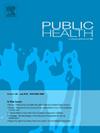综合探讨多基因风险评分对30种复杂疾病发病年龄的影响及贡献
IF 3.9
3区 医学
Q1 PUBLIC, ENVIRONMENTAL & OCCUPATIONAL HEALTH
引用次数: 0
摘要
目的多基因风险评分(PRS)在疾病风险预测中的应用前景日益广阔;然而,关于PRS对发病年龄影响的研究仍然有限。本研究旨在系统评估PRS对多种疾病发病年龄的影响。研究设计前瞻性队列研究方法我们用两种方法(C+T和PRS- cs)计算PRS,并比较它们对英国生物银行(UK Biobank) 30种疾病发病年龄的预测能力。接下来,我们评估了PRS对发病年龄的影响,并量化了PRS对早发和晚发病例疾病风险的影响。结果与C+T相比,sprs - cs在预测大多数疾病(阿尔茨海默病除外)的发病年龄方面表现更好。高PRS与23种疾病的早期发病年龄相关,平均发病年龄提前1.94岁。与女性相比,男性有5种疾病的发病时间较早。与平均PRS(20 - 80%)相比,PRS分布前2.5%的个体在19种疾病的发病年龄明显提前,从痛风的2.85(1.68-4.03)年到克罗恩病的13.70(9.88-17.52)年不等。与晚发组相比,早发组有21种疾病的发病风险更高,其中结肠癌早发风险是晚发风险的2.78倍(OR = 11.42[9.77-12.45]比3.95 [3.85-4.06],P <;0.001)。结论PRS越高,发病年龄越早,支持PRS在筛查慢性疾病易感早发高危人群中的潜在作用。本文章由计算机程序翻译,如有差异,请以英文原文为准。
A comprehensive exploration of the impact and contribution of polygenic risk score on age at onset of 30 complex diseases
Objectives
Polygenic risk score (PRS) has increasingly shown promise in predicting disease risk; however, studies examining the influence of PRS on age at onset remain limited. This study aimed to systematically assess the impact of PRS on age at onset across multiple diseases.
Study design
Prospective cohort study
Methods
We calculated PRS with two methods (C+T and PRS-CS) and compared their predictive capability in age at onset of 30 diseases in the UK Biobank. We next evaluated the effect of PRS on age at onset and quantified the influence of PRS on disease risk across early and late onset cases.
Results
PRS-CS behaved better in predicting age at onset of most diseases (except for Alzheimer's disease) compared to C+T. Higher PRS was associated with earlier age at onset for 23 diseases, with the average age at onset advanced by 1.94 years. Compared to women, men faced an advanced onset for 5 diseases. Compared to average PRS (20–80 %), individuals in the top 2.5 % of the PRS distribution displayed a significantly earlier age at onset for 19 diseases, ranging from 2.85 (1.68–4.03) years advancement for gout to 13.70 (9.88–17.52) years advancement for Crohn's disease. Compared to the late-onset group, the early-onset group exhibited a greater onset risk in 21 diseases, with the early-onset risk of colon cancer being 2.78-fold higher than the late-onset risk (OR = 11.42 [9.77–12.45] vs. 3.95 [3.85–4.06], P < 0.001).
Conclusions
Higher PRS generally leads to earlier age at onset, which supports the potential role of PRS in screening high early-onset risk individuals susceptible to chronic diseases.
求助全文
通过发布文献求助,成功后即可免费获取论文全文。
去求助
来源期刊

Public Health
医学-公共卫生、环境卫生与职业卫生
CiteScore
7.60
自引率
0.00%
发文量
280
审稿时长
37 days
期刊介绍:
Public Health is an international, multidisciplinary peer-reviewed journal. It publishes original papers, reviews and short reports on all aspects of the science, philosophy, and practice of public health.
 求助内容:
求助内容: 应助结果提醒方式:
应助结果提醒方式:


